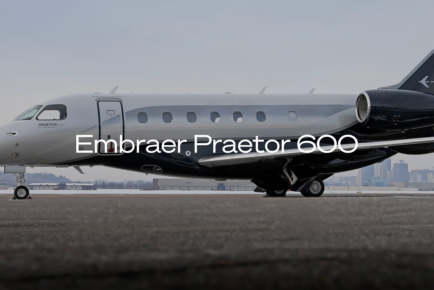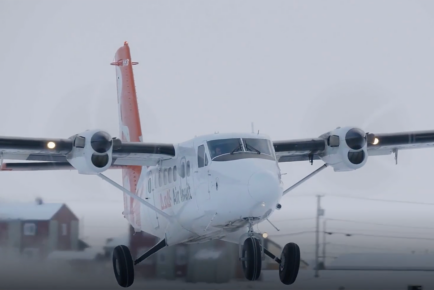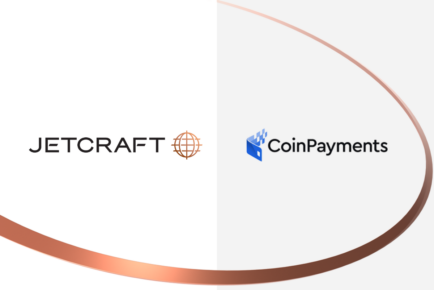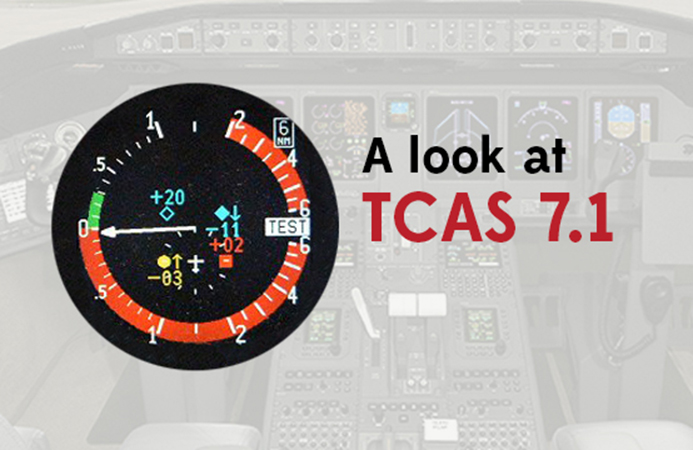
AvBuyer Magazine, May 2015
by Ken Elliott
Download a PDF of the article.
Helping you understand avionics advances and related mandates for equipage, Ken Elliot reviews aviation technologies within the NextGen/SESAR architecture, this month focusing on TCAS 7.1.
The midair collision over the Grand Canyon between two airliners in 1956 spurred the collaboration of industry and government in the development of a collision warning system. After a number of years using passive avoidance systems, industry realized the need for a predictive system, involving complimentary avoidance interaction between conflicting aircraft. In other word, if one aircraft decides to avoid another by climbing, the other aircraft needs to correspondingly descend. This necessary evolution eventually became TCAS II, with TCAS I being an advisory-only version of collision avoidance.
While technological advancements flourished, there was still a need for a practical solution that would avoid nuisance alerts in high-density traffic areas around busy commercial airports. In the early 1960s a scientist from Bendix Corporation touted an algorithm based on closure rate and time, rather than distance for predicting collision between aircraft.
In the 1980s Bendix-King (with United Airlines) and Honeywell (with Northwest Airlines) introduced the first commercial TCAS II. Ironically, Honeywell absorbed Bendix-King (as Allied Signal) at a later date, gaining significant avionics expertise from the acquisition. Another midair collision in California in 1986 prompted Congress to require FAA to mandate TCAS II in commercial aircraft, leading to a 1991 (subsequently delayed to 1993) requirement.
Initially the version of TCAS II adopted was labeled 6.0, which after several iterations became 7.0 in 1997. While TCAS II 7.0 incorporated a number of improvements over 6.0, one primary upgrade was to accommodate the requirement for reduced vertical separation minima (RVSM). Close separation of aircraft in the oceanic tracks and elsewhere introduced anomalies and nuisance alerts with TCAS II version 6. Today, versions of TCAS II are required worldwide in larger aircraft, including business jets.
TCAS Versions for ACAS
Traffic Alert & Collision Avoidance Systems (TCAS) are designed to meet the ICAO standard for significantly reducing the risk of midair collision. The system functions independently of groundbased air traffic control (ATC). For TCAS to be effective, however, all users of the different airspace sectors need to be transponder equipped and reporting, at a minimum, Mode C altitude.
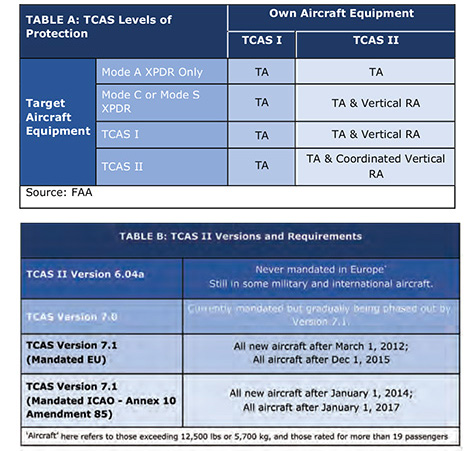 All TCAS systems provide collision threat information, alerting both audibly and visually, and displaying traffic on either a dedicated display or on a multifunction display. The two levels of traffic alerting—TCAS I and TCAS II—differ primarily by a function of their alerting capability (Table A).
All TCAS systems provide collision threat information, alerting both audibly and visually, and displaying traffic on either a dedicated display or on a multifunction display. The two levels of traffic alerting—TCAS I and TCAS II—differ primarily by a function of their alerting capability (Table A).
TCAS I: Providing real time traffic advisories (TAs) that assists pilots in visual acquisition of other aircraft that may become a threat, TCAS I is mandatory for US turbine powered passengercarrying aircraft having more than 10, and less than 31 seats. TCAS I has a range approximately of between 3-5nm, and consists of one antenna and a cockpit display.
Typically installed on General Aviation fixed-wing aircraft and helicopters, TCAS I is not a passive system as it interrogates, by design, other transponders. A less expensive version of TCAS 1 is Traffic Advisory System (TAS).
TCAS II: Introduced as a safety net to avoid potential mid-air collisions, TCAS II works independent of separation standards. Based on secondary surveillance radar (SSR) transponder signals, TCAS II interrogates Mode C and S transponders of nearby aircraft (‘intruders’). From the replies, TCAS II tracks intruder altitude and range, issuing alerts to the pilots, as appropriate. Aircraft that do not carry transponders are not detected. It should be noted that while TCAS II assesses threats from intruders, it does not take into account ATC clearance, pilot intentions or autopilot status.
TCAS II provides both traffic advisories and resolution advisories (RA). RAs provide recommended escape maneuvers, allowing the pilot to modify or regulate the vertical speed to either increase or maintain existing vertical separation between aircraft. It is the pilot who makes the final decision in the response to a resolution advisory, which provides a clear climb or descend (rate-based) command. RAs also sense the direction of other TCAS – equipped aircraft.
TCAS II is mandated by the US for commercial aircraft (including regionals) with more than 30 passenger seats or a MTOW greater than 33,000 lbs. Although TCAS II is not mandated domestically for Business and General Aviation, many turbine-powered aircraft and some helicopters are equipped with TCAS II.
In Europe, TCAS II version 7.0 has been mandated for over a decade on all aircraft with a take-off weight exceeding 5,700 kilograms, or if approved for a passenger seating configuration of more than 19 seats. ICAO mandated TCAS II version 7.0 in 2003 in all aircraft with greater than 30 passenger seats.
TCAS II requires two antennas mounted top and bottom of the aircraft, and is capable of both identifying and resolving traffic 14 miles ahead and 7 miles behind the aircraft. The system can process up to 30 aircraft simultaneously and has a one second process cycle. TCAS II Minimum Operations Performance Specifications (MOPS) were developed by RTCA as DO-185B and by EUROCAE ED-143.
Before we move on in our discussion of TCAS, it’s worth outlining the current status of Airborne Collision Avoidance System (ACAS) and Traffic Collision Alert Device (TCAD) technology:
- ACAS II: This is effectively an ICAO (Annex 10) standard.
- ACAS III: This system of the future was to be designed for horizontal and well as vertical alerting. However, a different concept – ACAS-X – is under development for introduction in the 2020 timeframe.
- TCAD: A purely passive unit that only listens to transponders is labeled TCAD. Transponders within range all need to be active, responding to other interrogations, in order to be sensed. TCADs and their active cousin TAS are mostly found on smaller GA aircraft.
TCAS: Traffic Advisory/Resolution Advisory
As we outlined above, there are two types of TCAS II aural and visual alerts, including Traffic advisory (TA), and Resolution Advisory (RA). The traffic advisory function (TA) prepares the pilot visually and aurally for a potential resolution. A resolution advisory (RA), however, immediately provides the pilot with the plus/minus range of vertical speed at which the aircraft needs to be flown to avoid a collision.
If a dedicated display is used, the RA is displayed on an outer ring representing vertical speed. Inside the rings are the individual targets:
- Blue for situational awareness traffic
- Yellow for traffic advisory, and
- Red for resolution requirement traffic. (The same red is used to indicate the vertical range on the outer ring.)
After traffic aural warnings are provided and “climb” or “descend” appropriately responsive action taken, a “clear of conflict” message is provided to the crew. The goal of the aircraft TCAS communications is to ensure that one aircraft’s resolution complements the other’s. If one aircraft receives a climb command, the other is commanded to descend, and a safe separation RA of between 300 and 700 feet can be expected.
Imagine that each aircraft surrounds itself with a constantly changing protective bubble, the shape and size of which is dictated by the virtually instantaneous performance or movement status of the aircraft. RAs vary based on the aircraft’s speed, heading, altitude and apparent intention, with urgent RA’s being issued without prior TA warning. The TCAS II will update the situation every second.
TCAS II is designed to a Technical Standard Order (TSO) C119c and all TCAS manufacturers are required to follow that standard in performance capability of their equipment. There are three major suppliers of TCAS II today; Honeywell, Rockwell Collins and ACSS (a division of L-3 Aviation Products). Note that Honeywell owns Bendix-King, which supplies business jet versions of TCAS systems within the Honeywell family.
Even if an RA is contrary to an ATC clearance or instruction, the pilot is required to immediately comply with its command provided he/she deems the action to be safe. Under ICAO standards, a pilot is obliged to follow resolution advisories unless doing so would endanger the aircraft. In the US a pilot may disregard an RA if the pilot has made a definitive visual acquisition of the other aircraft. Complying with the RA, however, will in many instances cause an aircraft to deviate from its ATC clearance. In this case, the controller is no longer responsible for separation of the aircraft involved in the RA.
Unless ATC receives the RA downlink, the controller will be unaware of RAs being commanded between conflicting aircraft. The pilot should communicate the RA and its resultant flight level to the controller so that a new flight path can be generated. ICAO has no RA downlink provisions at this time. (Note that TCAS II as installed will communicate the equipage and operational status to ADS-B.)
TCAS II version 7.1
RTCA DO 185B and EUROCAE ED-143 provide TCAS II version 7.1 guidance. Primarily TCAS 7.1 enables mitigation of the risk for a mid-air collision in situations where aircraft flight tracks are closer, such as with FANS 1A airspace. There are three significant issues addressed by TCAS II version 7.1:
- Reversal logic enhancement
- “Level off” aural alert
- Change to descend RAs at low altitude
There are four additional minor issues addressed by TCAS II version 7.1:
- It corrects an issue that occurs as an aircraft descends through 1,000’ above ground level (AGL);
- It transmits the TCAS II processor part number and level of software;
- It corrects for multi-aircraft logic concerns, reducing the risk of close encounters within RVSM airspace;
- It modifies the status report sent to the aircraft’s Mode S transponders informing of its 7.1 Hybrid Surveillance capability.
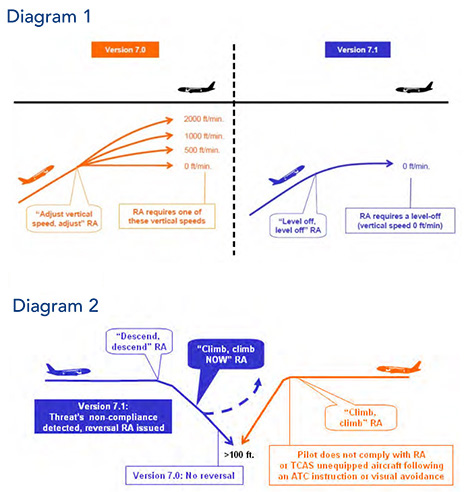 Problems with Adjusting Vertical Speed: The “Adjust vertical speed, adjust” RA command has been replaced by “Level off, level off” to prevent the problem of pilots increasing rather than decreasing the vertical speed, as a natural response to the original command format (see Diagram 1 ‘TCAS II Version 7.1 Level Off’, courtesy of SKYbrary.)
Problems with Adjusting Vertical Speed: The “Adjust vertical speed, adjust” RA command has been replaced by “Level off, level off” to prevent the problem of pilots increasing rather than decreasing the vertical speed, as a natural response to the original command format (see Diagram 1 ‘TCAS II Version 7.1 Level Off’, courtesy of SKYbrary.)
Problems with Reversal Logic: In certain instances version 7.0 TCAS II failed to reverse an RA when two converging aircraft remained within 100ft. This was because version 7.0 allows for reversal of RAs when the current RA is no longer predicated to provide sufficient vertical spacing. A feature has been added in version 7.1 that monitors RA compliance in coordinated encounters. Thus, when a version 7.1 TCAS detects that an aircraft is not responding correctly to an RA, it will issue a reversal RA to the aircraft that will then maneuver in accordance with the RA (see Diagram 2, ‘TCAS II Version 7.1 reverse logic’, courtesy of SKYbrary.)
Incorporating Version 7.1
On March 18, 2014 the FAA issued a Revision B to Advisory Circular 20-151 for the airworthiness approval of TCAS systems and associated transponders. The Advisory includes significant changes to the previous ‘A-version’ and mostly centers on hybrid surveillance functionality. The latest TCAS II TSO Standard, TSOC119d, requires RTCA/DO-300A Hybrid Surveillance functionality. This requirement has been added to the TSO and airworthiness approval guidance to reduce congestion on the 1090 MHz frequency while the system is airborne and when on the ground.
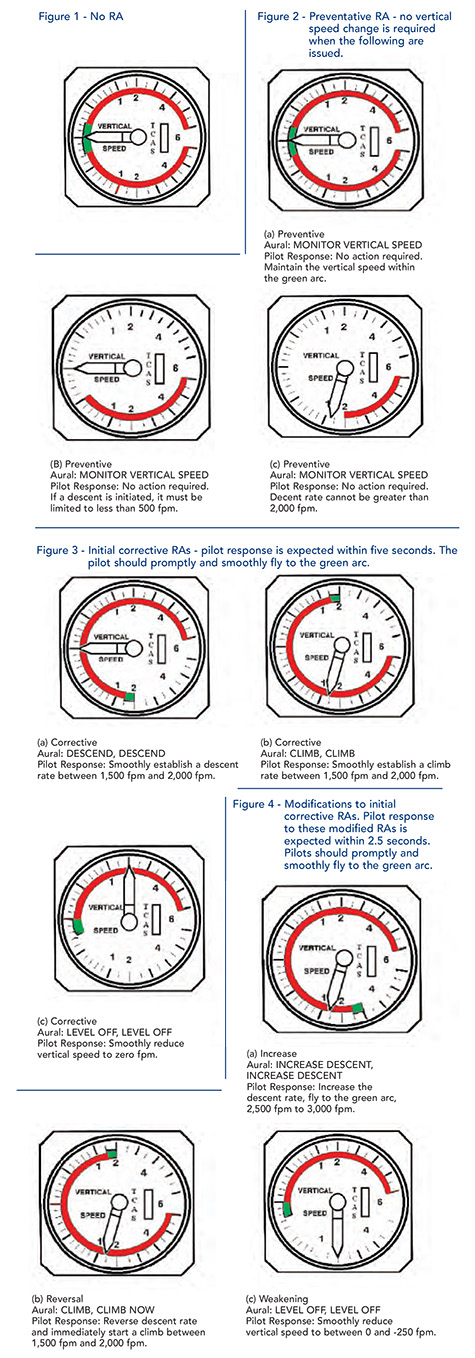 From a pilot’s perspective, when airborne there will be no difference in operation of a TSOC119d traffic display verses earlier variants. However, when the aircraft is on the ground and TCAS is in the TA or TA/RA mode, traffic advisories will not be annunciated. This reduces the burden on the 1090 MHz frequency during ground operations, as the TCAS systems are essentially passive.
From a pilot’s perspective, when airborne there will be no difference in operation of a TSOC119d traffic display verses earlier variants. However, when the aircraft is on the ground and TCAS is in the TA or TA/RA mode, traffic advisories will not be annunciated. This reduces the burden on the 1090 MHz frequency during ground operations, as the TCAS systems are essentially passive.
Figures 1-4 depict a typical set of RA vertical speed responses from the Advisory Circular showing the modified system.
A GA Problem
In 2011 the FAA issued a Safety Alert for Operators (SAFO) centered on both the occurrence and response to RAs. GA operators with TCAS II will likely be flying business jets; TCAS I, TAS and TCAD equipment meet the needs of most GA applications. These business aircraft are more likely to conflict with VFR traffic at lower altitudes, creating more TA and RA occurrences than Part 121 traffic. Also, Part 121 crews have a better track record of compliance with the operating requirements of TCAS II.
Most business aircraft RAs occur in the Northeast US and within Class C or D airspace. Pilots are likely to see other aircraft when close and therefore ignore an RA. The FAA advises that operators review their training programs and follow Advisory Circular AC 120-55 guidance. Pilot Operating Handbooks should be updated.
Accomplishing the Upgrade
For most existing TCAS 7.0 systems, the upgrade to TCAS 7.1 involves a software change to the TCAS processor itself. However, there may be some wiring considerations if upgrading is part of an ADS-B installation, depending on the specific aircraft type and overall ADS-B equipment. The bigger concern is the amendment requirement of the TC or STC that installed the existing TCAS II Version 7.0 currently in the aircraft.
Although the software upgrade to the TCAS II processor may be ready, the aircraft approval to use it may not be. If the STC was completed by a third-party, it is highly recommended that operators discuss the amendment with the STC holder, who may not be your preferred MRO. Even STC amendments can take considerable time as STC applicants and holders join the line of those waiting for approvals. With ADS-B/FANS STC applications mounting, delays may be extended.
If an upgrade pertains to recent aircraft, the factory solution is likely to be ready or well underway. For legacy aircraft the solution may be an MRO option and not yet tackled by the existing aircraft OEM. The OEM tends to work backwards from later models to earlier, while MROs seize the opportunities existing in legacy aircraft where no OEM solution is likely to offer competition. In essence, MROs tend to look for the sweet-spot of aircraft models, where residual value still justifies the expense of upgrading and a healthy demand exists.
When last checked, all the Dassault Honeywell EASy II cockpits with TCAS 2000 have the 7.1 upgrade available to meet the December 2015 requirement for operators flying in and out of Europe. For the Dassault Falcon 900B using Honeywell CAS 81A, the solution was well underway in late 2014, and for Falcon 900EX and 900C with Honeywell Elite II there is no current factory solution.
For Gulfstream’s G450 and G550 the TCAS upgrade is serial number-specific, while for GIV and GV the upgrade is equipment-specific. Bombardier, Embraer, Cessna and Hawker Beechcraft models outfitted with TCAS II have 7.1 capability available, but check with the OEM for specific readiness based on aircraft model, serial number range and TCAS II equipage.
Are you looking for more articles on avionics? Visit www.avbuyer.com/articles/category/business-aviation-avionics/
❯ Ken Elliott is a highly-respected industry authority on avionics as a member of the NextGen Advisory Council sub-committee and Technical Director, Avionics at Jetcraft. Contact Ken via [email protected] or www.www.jetcraft.com.
This article was written by Ken Elliott, Jetcraft Avionics – Technical Director, for AvBuyer Magazine. It was published in the May 2015 issue. Click here to view the Digital issue of the May AvBuyer or to view Archived editions.
SIGN UP FOR OUR MONTHLY JETSTREAM RECAP
Don't miss future Jetstream articles. Sign up for our Jetcraft News mailing list to receive a monthly eblast with links to our latest articles. Click to join the 1,800+ subscribers on our mailing list.


